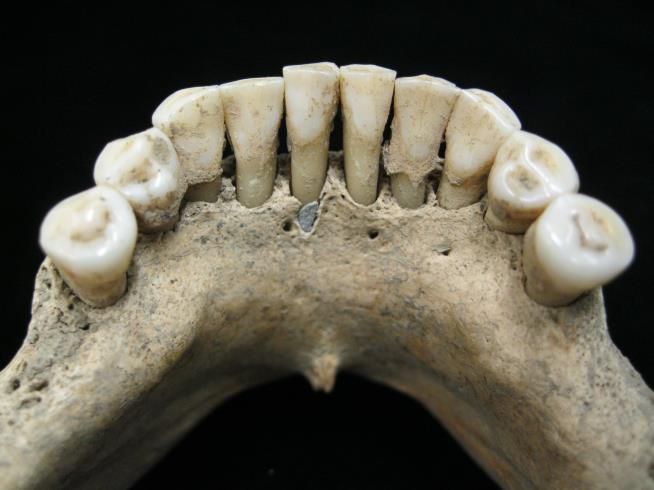
Posted on 01/15/2019 4:54:41 PM PST by SJackson
Discovery suggests women worked as top artists in Middle Ages more often than thought

They couldn't figure out the blue. Scientists studying tartar from the teeth of medieval skeletons hoped to learn a thing or two of about diets of the Middle Ages. But when they put the teeth and jaw of one woman under a microscope, they were surprised to see hundreds of tiny flecks of blue, reports the BBC. After much sleuthing, they figured out that the blue came from lapis lazuli, a rare and expensive stone ground into powder to make dye for sacred manuscripts. Typically, male monks have gotten most of the credit for working on such texts, but the amount of lapis lazuli in the woman's mouth suggests that she—and presumably other women—were also on the job. Researchers' best guess is that the blue flecks ended up in her teeth because she kept putting the tip of her brush in her mouth, reports the AP. The fastest way to pay off $10,000 in credit card debt Sponsored Content The fastest way to pay off $10,000 in credit card debt By CompareCards
"It's kind of a bombshell for my field—it's so rare to find material evidence of women's artistic and literary work in the Middle Ages," says Alison Beach of Ohio State University, a professor of medieval history and co-author of the report in Science Advances. Another possibility is that the woman breathed in the lapis lazuli, known as ultramarine in its powder form, while preparing it for someone else, notes the Atlantic. The woman was found buried beneath an ancient cemetery in Germany and was likely a nun, say researchers. She lived between 997 and 1162AD and probably died around age 60. "For a medieval historian, this kind of clear material evidence of something from the life of an individual person is so extraordinary," says Beach. (Read more discoveries stories.)
..................
Top artist, maybe. Might suggest they were involved in the process. Of jewelry making, or dye or pigment making.
ping
I only came here to find out the fastest way to pay off $10,000 in credit card debt. Thanks!
Women use all kinds of weird things as makeup. Are these researchers really sure that these women weren’t using some kind of lip makeup that involved ground lapis lazuli?
They were drinking blue Gatorade?
I think that’s a possibility. Lapis was ground for use as a pigment.
The answer seems to be to become a scribe for some monk. I didn't realize monks had that much money.
Were blue teeth fashionable at that time and place?
I thought this going to be about Hillary and Monica.
And women were chosen as the grinders, hence the blue flecks in their teeth. Spit don't swallow!
As the Trappists make jams and jellies, maybe she was making a batch of Blue Nun.
“The fastest way to pay off $10,000 in credit card debt Sponsored Content The fastest way to pay off $10,000 in credit card debt By CompareCards”
Fascinating.
Another example of toxic masculinity!
Lapis Lazuli would be ground fine, mixed with medium, and used to paint the blue Virgin’s veil. This was an artist who ingested a lot of blue pigment over a long time. I’ve never heard whether it’s toxuc.
Recycled article
Thank you. I actually READ this earlier this morning. lol
What I found just as interesting as the fact their were women scribes, is how extensive this particular tint and source was actually used. Pretty incredible history for a rock. :)
Lapis Lazuli would be ground fine, mixed with medium, and used to paint the Virgin’s blue veil. This was an artist who ingested a lot of blue pigment over a long time. I’ve never heard whether it’s toxic. Manganese, cadmium are toxic.
It's well-known that nuns were very active in sacred and liturgical arts, including the making of vestments and altar cloths, illuminated manuscripts, furnishings for the altar and paintings including elaborate rood screens and painted wood carvings.
In the early Middle Ages--from the fifth century to the year 1,000 , more or less ---there were dozens of great (major) abbesses who ruled and dispensed justice, mastered both the the practical and liturgical arts, and kept learning alight.
An excellent example is St. Hilda of Whitby. According to her biographer, the Venerable Bede, "not only ordinary people but monks and kings and queens from afar streamed to her" for instruction in the arts and literature, and for advice and counsel.
Hilda was the abbess of the great double monastery at Whitby, ruling over not only her own community but a monastery of friars as well. St. Hilda emphasized learning for her friars and nuns. They studied scripture. They illuminated manuscripts. They solved mathematical riddles--for fun!
The well-documented histories of Hilda of Whiby, Hildegard of Bingen, Teresa of Avila, Bridget of Sweden and their artistic and illustrious sisters (especially my favorites, the splendid Rhineland Benedictines),is evidently news to some!
Disclaimer: Opinions posted on Free Republic are those of the individual posters and do not necessarily represent the opinion of Free Republic or its management. All materials posted herein are protected by copyright law and the exemption for fair use of copyrighted works.